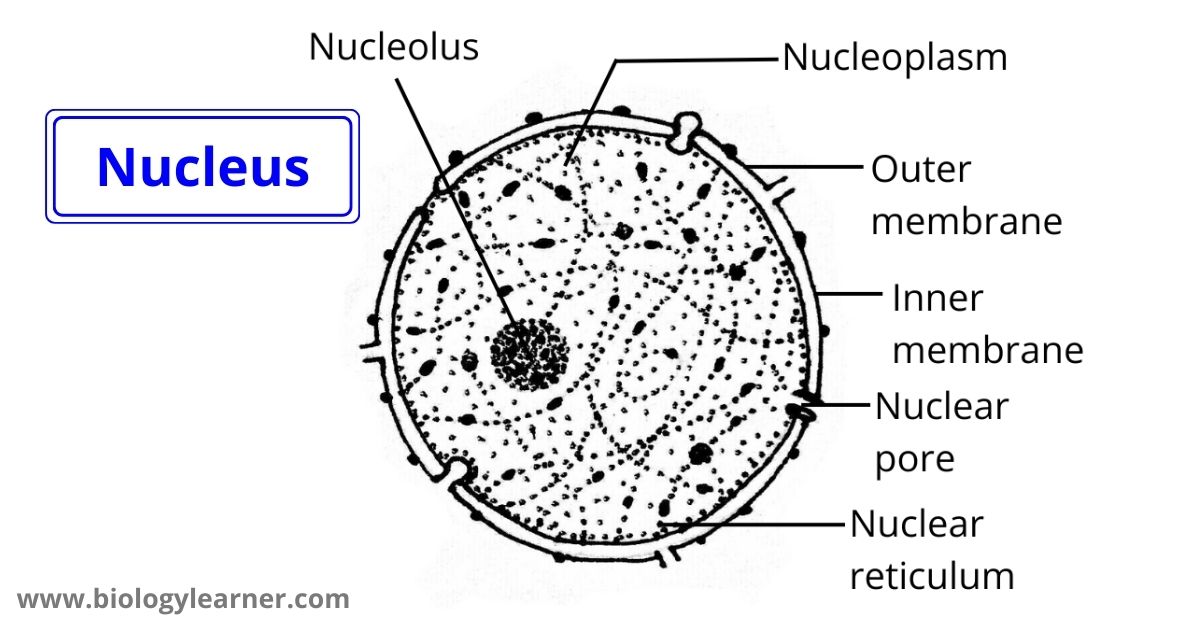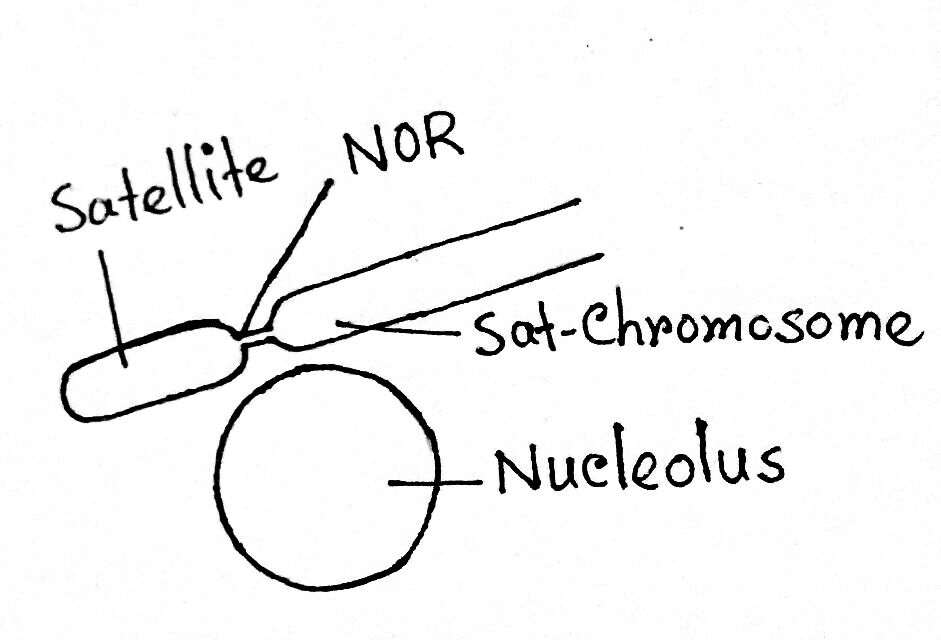A nucleus is the largest cell organelle in a typical cell. Which is a highly organized globular, ellipsoidal, spherical, or disc-shaped protoplasmic body enclosed within the cytoplasm. Robert Brown first discovered and coined the nucleus in 1831.
The Latin word, “Nucleus = Kernel or Seed”
It contains the hereditary material (information) or DNA. It controls the various biological processes in the cell and is called “the brain of the cell”.
Definition of Nucleus
The nucleus is a spherical or disc-shaped double membrane-bound cellular organelle present within the protoplasm of the typical cell which contains the hereditary information and controls the metabolic functions of the cell.

Origin of Nucleus
According to the evolutionary viewpoint, the nucleus originated from the nucleoid (proto nucleus). In the nucleoid, DNA remains naked (only chromatin materials) without the presence of a membrane.
In a typical cell, the chromatin materials (naked DNA) in the aggregation are enclosed within a membrane (nuclear membrane) to form the nucleus.
Location of Nucleus
The nucleus generally lies in the central position of the Eukaryotic cell (A typical nucleus is absent in the Prokaryotic cell). It occupies a considerable proportion of the volume of the cell. Sometimes as much as 2/3rd or 3/4th- but this proportion becomes less during differentiation. Due to the development of a big vacuole in the center of the cell (plant cell), the nucleus moves to the periphery.
In some eukaryotic cells such as RBC and the sieve tube of the phloem, the nucleus is not present.
Ultrastructure of a Nucleus
A typical nucleus has four parts seen in the electron microscope:
- Nuclear membrane
- Nucleolus
- Nucleoplasm or Nuclear sap
- Nuclear reticulum
Nuclear Membrane
The double lipoprotein membrane that surrounds the nucleus from the outside is called the nuclear membrane. The nuclear membrane is also known as nucleo-lemma or karyotheca.
Under an electron microscope, the nuclear membrane appears as a double membrane structure having pores at regular intervals. The membrane facing the cytoplasm is called the outer membrane or ectokaryotheca. While the membrane facing the nucleoplasm is called the inner membrane or endokaryotheca. Both outer and inner membranes are measuring about 75-90 Å in thickness and consist of lipids and proteins.
The two membranes are separated by a space full of fluid which is about 100-150 Å in diameter. This space is called perinuclear space or perinuclear cisternae.

The outer nuclear membrane is connected with the ribosome and the endoplasmic reticulum. The inner nuclear membrane is connected with the fibers-like nuclear lamina or honeycomb layer or nuclear cortex (made up of proteins).
The nuclear membrane has numerous pores which are called nuclear pores. Each pore is oval-shaped and about 120 nm in diameter. These pores consist of three parts – scaffold, radial arms, and internal transporter.
Function of Nuclear Membrane
- The nuclear membrane provides a specific shape to a nucleus.
- This membrane protects the nuclear material.
- It controls the interaction between the nucleoplasm and cytoplasm.
- The cisternae of the endoplasmic reticulum are formed by the method of blebbing from the nuclear membrane.
- It controls the movement of inorganic ions and micro-organic molecules.
- Nuclear pores function as the exit path of the ribosomes and RNA.
Nucleolus
The nucleolus is a prominent, spherical, colloidal, acidophilic structure found in the nucleus of a typical cell.

It is mainly composed of phosphoproteins and RNA. The electron micrograph and immunocytological techniques show that three distinct regions are observed in the nucleolus. These are the Fibrillar center, Dense fibrillar component, and Cortical granular components.
- Fibrillar Center: This pale-staining part represents the innermost region of the nucleolus, which is made up of ribosomal DNA. The RNA genes of the nucleolar organizer of chromosomes are located in this region. The transcription (ribosomal RNA synthesis) of these genes is also initiated in this region.
- Dense Fibrillar Component: This region surrounds the fibrillar center. RNA synthesis progresses in this region. The 70 ribosomal proteins (rps) also bind to the transcripts in this region.
- Cortical Granular Components: This is the outermost region of the nucleolus, where progression and maturation of pre-ribosomal particles occur. This region looks granular in the electron microscope. The granules (also known as ribosome granules) are 15-20 nm in diameter.
However, more dense nucleolar associated chromatin is seen on the outside of the nucleolus. Which does not participate in the formation of the nucleolus.
Function of Nucleolus
- The nucleolus synthesizes and stores RNA.
- It helps in the synthesis of the ribosomal subunits.
- The nucleolus plays an important role during cell division.
- It helps the formation of the spindle during karyokinesis. During cell division at the last prophase or pre-metaphase stage, the nucleolus in the nucleus disappears. While the nucleolus again reappears at the telophase stage.
Nucleoplasm
Nucleoplasm is a transparent, semi-solid (quasi fluid), granular, and slightly acidophilic ground substance or the matrix of the nucleus present in the space between the nuclear membrane and the nucleolus.
It is also known as Nuclear sap or Karyolymph. The nuclear components such as the chromatin threads and the nucleolus remain suspended in the nucleoplasm.
The nucleoplasm has a complex chemical composition. It is mainly composed of nucleoproteins (phosphoproteins and histone proteins). However, it also contains other organic and inorganic substances like – nucleic acid (RNA), enzymes (DNA-polymerase, RNA-polymerase), and minerals (P, K, Na, Ca, Mn, Mg), and proteins.
Function of Nucleoplasm
- The nucleoplasm forms the nuclear skeleton and maintains the size and volume of the nucleus.
- It contains the nucleolus.
- The function of all types of enzymes in the nucleus takes place at the nucleoplasm.
Nuclear Reticulum
The nuclear reticulum is the thread-like, coiled, and many elongated structures present within the nucleoplasm of a nucleus.
These long, thread-like, coiled structures, composed of nucleoproteins are also known as chromatin fibers. Such chromatin fibers are formed mainly in the interphase nucleus of the cell division.
During the cell division (meiosis and mitosis), chromatin fibers become thick ribbon-like structures which are called chromosomes.

Chromatin fibres are two types: Heterochromatin and Euchromatin.
Heterochromatin
The more condensed region of chromatin thread that takes more stain in the resting nucleus is called heterochromatin.
This region of the chromatin remains in highly coiled condition and does not undergo any change during cell division. It contains a comparatively small amount of DNA and a large amount of RNA.
Euchromatin
The chromatin region that takes less stain at the resting nucleus is called euchromatin.
During cell division though the region remains in a coiled state, but in the resting nucleus, the region becomes extended.
Function of Nuclear reticulum
- The nuclear reticulum forms chromosomes during cell division.
- Chromatin fibers carry hereditary information.
Functions of Nucleus
The functions of the nucleus are as follows:
- The genetic material of a nucleus is DNA, which carries the genetic information.
- The nucleus plays an important role in RNA and ribosome synthesis.
- It controls all the biological activities of the cell.
- The nucleus helps in cellular differentiation by controlling gene expression.
- It also plays an important role in biological evolution by genetic variations.
- The nucleus controls cell division and gene replication.
References
- Lam, Y. W., Trinkle-Mulcahy, L., & Lamond, A. I. (2005, April 1). The nucleolus. Journal of Cell Science, 118(7), 1335–1337. https://doi.org/10.1242/jcs.01736
- Verma, P. S., & Agrawal, V. K. (2006). Cell Biology, Genetics, Molecular Biology, Evolution & Ecology (1 ed.). S .Chand and company Ltd.
- Lammerding, J. (2011, April). Mechanics of the Nucleus. Comprehensive Physiology, 783–807. https://doi.org/10.1002/cphy.c100038
- Guo, T., & Fang, Y. (2014, August 12). Functional organization and dynamics of the cell nucleus. Frontiers in Plant Science, 5. https://doi.org/10.3389/fpls.2014.00378
- Jevtić, P., Edens, L. J., Vuković, L. D., & Levy, D. L. (2014, June). Sizing and shaping the nucleus: mechanisms and significance. Current Opinion in Cell Biology, 28, 16–27. https://doi.org/10.1016/j.ceb.2014.01.003
